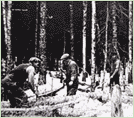
For the first 400 years after the discovery of Newfoundland the forest was used almost exclusively as a support for the fishery. In addition to the construction of premises, wood was essential for fuel, boat building, and the construction of stages and flakes used for splitting, salting and drying codfish.
It became a tradition for fishermen to regard the coastal forest zone as their reserve to which they had free access. This tradition became incorporated into law in the Crown Lands Act of 1930 which specified a three-mile coastal limit for the use of fishermen. This three-mile limit law was eventually repealed.
By the mid-1800s it was apparent the fishing industry could not support the population. To assist diversifying the economy and developing the forest and mineral resources of the interior of Newfoundland a railway was constructed across the Island. The trans-island railway was completed in 1898. The railway had two major influences on the province; one was the access to the interior and the second was the 145 blocks of land comprising 3,910 square miles granted to R. G. Reid for constructing the railway. In the early 1900s additional timber leases were issued in response to the construction of pulp and paper mills in Grand Falls and Corner Brook. These grants and leases are still in existence today.
By the beginning of the nineteenth century, sawmilling, primarily of White Pine was a flourishing industry. The industry peaked in 1904 when 20 million board feet was sawn. However, it was apparent the better White Pine stands had been logged and the timber species (spruce/fir) were of relatively small diameter and consequently too small for economic production of lumber for export.
In 1909 the Anglo-Newfoundland Development Company (AND) started a pulp and paper mill in Grand Falls. The mill ownership changed in 1965 to Abitibi-Price Inc. . A second pulp and paper mill started construction in Corner Brook in 1923 by Newfoundland Power and Paper Company Ltd. In 1925 the mill was acquired by the International Power and Paper Company. Bowater Newfoundland Ltd. purchased the mill in 1938 and operated it for 46 years before it was purchased by Kruger Inc. of Montreal. A third pulp and paper mill started in 1979 in Stephenville. Abitibi-Price Inc. purchased the Labrador Linerboard Mill and converted the facility to a pulp and paper mill.
Up to the early 1900s it was not considered necessary to protect the forest resource. But with the evolving forest industry, forest fire control became the initial management action. This situation remained largely in effect until the appointment of the country's first Chief Woods Ranger in 1905, efforts under the Commission of Government in the 1930's and subsequent Confederation with Canada in 1949. The new provincial government of 1949 had a policy for the economic development of the province and the conservation of her natural resources. As a result of this policy, economic development of the province’s resources was given high priority.
Basic forest protection (fire and insects) was the primary forest management action within the province for the early 1900s to 1975. A Forest Land Management and Taxation Act was proclaimed in 1975. This Act established the administrative management structure that exists today (i.e., creation of forest management plans, the authority to declare those with tree cutting rights not managed resulting in a higher land tax rate). Throughout the 1980s the provinces silviculture program (planting, pre-commercial thinning) evolved.
In 1990 a new Forestry Act was proclaimed which changed the management focus from soley timber management, to managing the forest for timber while considering other resource management objectives, sound environmental practices and the principle of sustainable development. To accomplish this mandate, planning teams have been established in forest management districts across the province. These teams are comprised of forest industry representatives, government resource managers, non-government organizations and the public. These teams work with district managers to determine forest values and prepare a forest management plan for the district.
